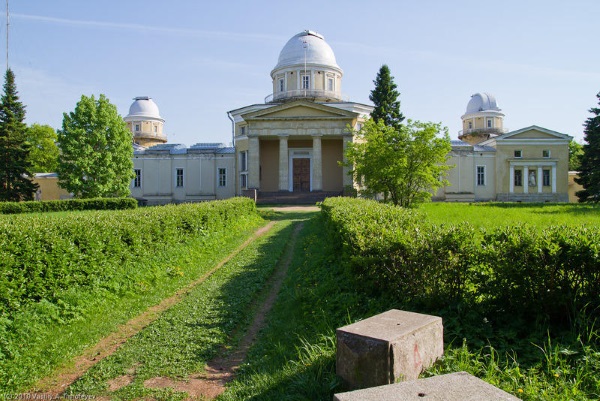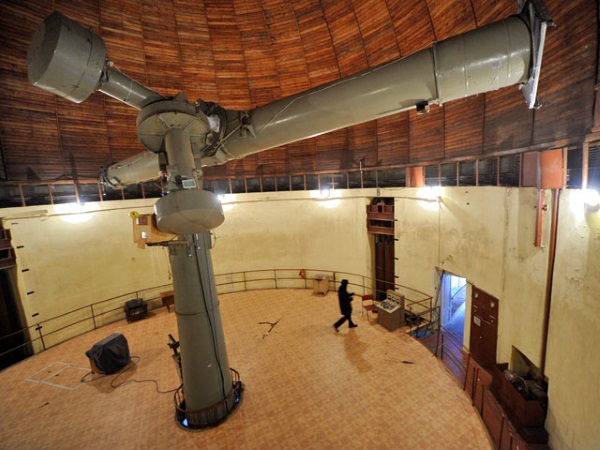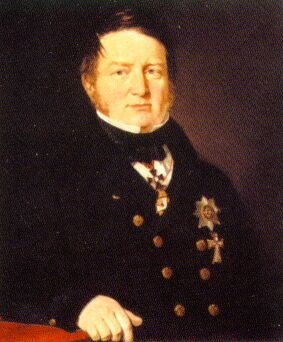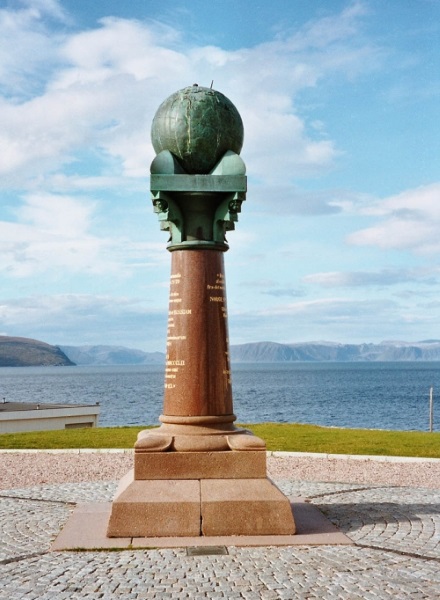Over the course of almost two centuries Pulkovo Observatory has served as the source of so many plots in the history of Russian science that they can be compared to… while no, perhaps not to the number of stars on clear night, but nonetheless…

Perhaps it’s no coincidence that many famous observatories are compared to monasteries. The first factor is their location in remote places, away from the city bustle, most often in the mountains where the air is not polluted. The second factor is their concentration on sheer heavenly rather than earthly objects. The third factor is arises in the ministers of this “religion” – the star-gazing astronomers.
One of the oldest observatories in Russia is the Pulkovo observatory. No, it’s not the oldest of all – there was also a site for observing the luminaries at the Academy of Sciences. But a big city is always a big city and so tsar Nicholas I, crazy about technical sciences and novel technologies, supported the project of building a big observatory on Pulkovo Hills.
About 20 hectares of land were urgently bought out from local peasants, 14 verst from the Northern Capital… By Petersburg’s yardstick those hills are the Alps if not Himalayas: 248 feet or 75 meters above the level of the Kronstadt tide gauge, the ancient altitude measuring benchmark in Russia. The classical architectural ensemble of the observatory was built after the project drafted by Alexander Brullov. The construction was completed within 4 years and no money was spared, with total expenditures exceeding 2 million rubles. The observatory was equipped with the latest German optical devices.
Brullov’s creation, but not a painting

Over the course of almost two centuries Pulkovo Observatory has served as the source of so many plots in the history of Russian science that they can be compared to… while no, perhaps not to the number of stars on clear night, but nonetheless… its fate in the 20th century was most dramatic… The whole thing started with the notorious “Pulkovo case”, when several dozens of astronomers led by the director were executed on allegation of their involvement in “a fascist Trotskyite terrorist organization.” Later, during WWII, people from one of the most scientifically advanced nations in the world, compatriots of the observatory’s first director Friedrich Wilhelm Georg (baptized as Basil) Struve (1793-1864) razed its structures with their bombs and artillery.
But in Russia sadness is often followed by joy. Some of the instruments were rescued, including the lenses of the famous 30-inch refractor along with a large part of the unique library whose oldest artifacts date back to the 15th century. The Observatory also was lucky to get such a restorer as academic Shchusev, who thought it necessary and possible to restore the structures on the basis of Brullov’s drawings.
Now the “star wardens” should finally be content: for almost a quarter of a century the Observatory has been part of the UNESCO Heritage site “The Historical Center of Saint Petersburg…” In 1997 it was included in the state registry of particularly valuable cultural heritage objects, with its more than 300 employees and several branches. One of the latter, built on Mount Koshka in the town of Simeiz (Crimea) on the funds of wealthy patron of art and amateur astronomer Nikolay Maltsev, deserves to be described in a separate book. Like also each of the brilliant academics who worked with its telescopes: Viktor Ambartsumyan, Dmitry Maksutov, Boris Strugatsky… Yet according to sociologists, the biographies of great scientists are not popular at present.
It’s a pity, since Mr Struve would be the first in this row – not just a prominent scientist, but also the founder of an outstanding dynasty. The well-known contemporary publisher Nikita Struve is the grandson of the eminent philosopher and columnist Peter Struve who in his turn was a grandson of the Observatory’s founder. Of all that elder Struve did for Russia, his famous geodetic arc seems to be the most fantastic – a chain of survey triangulations stretching from Hammerfest in Norway to the Black Sea, through ten countries and over 2,820 km, which yielded the first accurate measurement of a meridian and was included in the UNESCO World Heritage List in 2005.
Measuring the shape of the Earth

What is the Struve Geodetic Arc? In short, it is a chain of triangulation 265 points created over a period of 40 years from 1816 to 1855. Thirteen points were most crucial, representing combined astronomic-geodesic points where astronomic identification of latitudes and azimuths was performed.
The triangulation points were marked in various manners on the terrain: for instance, recesses carved in rock, iron crosses, cairns or specifically installed obelisks. They were often marked with sandstone bricks laid at the bottom of a pit. And sometimes this was a granite cube with a cavity where lead was poured and which was then placed in a pit with cobblestones. Terminal points were enshrined as monuments when the arc was being created.
The arc’s purpose was to identify the Earth’s parameters, its shape and size. This measurement of our planet’s shape was the first one in Russia’s national history: the research done corroborated that the Earth is not spherical but ellipsoid.
The 2,820-km arc stretched across Eastern Europe, covering 25 degrees and 20 minutes, or 1/14 of the Earth circumference – from Norwegian Fuglenes near Nordcap to the Ukrainian village of Staraya Nekrasovka near the Danube delta. However, Basil Struve could hardly foresee the destiny of his creation, and not just that only 34 measurement points remain.
At the time of its creation the arc was spanned the territory of only two nations: The Swedish-Norwegian Union and the Russian Empire. Today the remaining 34 points are shared by Norway, Sweden, Finland, Russia, Estonia, Latvia, Lithuania, Belarus, Ukraine and Moldova. Strange though it may seem, Belarus torn by many wars boasts the greatest number of remaining points (nine according to encyclopedias and 19 according to Byelorussian scientists) along with Finland. Russia, regardless of any discussions about the inscrutability of historical fortunes, now has only two (Mäkiinpäällys and Point Z serving as the link between the northern and southern parts of the Arc), but even these are lost in the Gulf of Finland 180 km west of St. Petersburg on the isle of Hogland (administratively, part of the Kingisepp district in the Leningrad region).
In Struve’s footsteps

It is reasonable to ask what should be done to this Arc today in the age of satellites and other sophisticated and precisely calibrated equipment? To begin with, it is necessary to preserve it: not without reason is it believed that nobody has ever seriously examined what has been left of it in the Ukraine or in Moldova. True, worthy monuments can be found almost in all countries that hosted the Arc.
The second question is: what do European traveling agencies care? They propose quite a few routes connecting several countries, such as the Great Silk Way and the Great Tea Way. Strangely though, they mainly run in the latitude direction, but no longitudinal routes have so far been suggested.
The Struve Arc is greatly respected in Belarus. Certain historic luck is complemented by the fact that our Byelorussian brothers were almost the first to note that those points are predominantly located in the wildest nature preserves which lure contemporary travelers. So they pegged both special tourist routes and quaint rural estates to the arc’s points. To the best of my knowledge, Finland lacks special routes; yet the arc’s points are always pointed out to travelers. In Russia such routes are still in the pipeline – in particular, as part of the Ingermanland nature preserve on the Isle of Hogland.
… And lastly, a funny story: in 2006 they minted a 20-ruble memory coin in Belarus devoted to the Struve Arc. This was a square coin with orbed angles. But the trouble is that a wrong length of the arc was indicated on the coin’s reverse side, 60 km longer than in reality or 2,880 km! It is rumored that part of the mintage was withdrawn from circulation, but in the Byelorussian numismatic market the coin turned into one of the most expensive lots.
Georgy Osipov

 Perhaps it’s no coincidence that many famous observatories are compared to monasteries. The first factor is their location in remote places, away from the city bustle, most often in the mountains where the air is not polluted. The second factor is their concentration on sheer heavenly rather than earthly objects. The third factor is arises in the ministers of this “religion” – the star-gazing astronomers.
Perhaps it’s no coincidence that many famous observatories are compared to monasteries. The first factor is their location in remote places, away from the city bustle, most often in the mountains where the air is not polluted. The second factor is their concentration on sheer heavenly rather than earthly objects. The third factor is arises in the ministers of this “religion” – the star-gazing astronomers. Over the course of almost two centuries Pulkovo Observatory has served as the source of so many plots in the history of Russian science that they can be compared to… while no, perhaps not to the number of stars on clear night, but nonetheless… its fate in the 20th century was most dramatic… The whole thing started with the notorious “Pulkovo case”, when several dozens of astronomers led by the director were executed on allegation of their involvement in “a fascist Trotskyite terrorist organization.” Later, during WWII, people from one of the most scientifically advanced nations in the world, compatriots of the observatory’s first director Friedrich Wilhelm Georg (baptized as Basil) Struve (1793-1864) razed its structures with their bombs and artillery.
Over the course of almost two centuries Pulkovo Observatory has served as the source of so many plots in the history of Russian science that they can be compared to… while no, perhaps not to the number of stars on clear night, but nonetheless… its fate in the 20th century was most dramatic… The whole thing started with the notorious “Pulkovo case”, when several dozens of astronomers led by the director were executed on allegation of their involvement in “a fascist Trotskyite terrorist organization.” Later, during WWII, people from one of the most scientifically advanced nations in the world, compatriots of the observatory’s first director Friedrich Wilhelm Georg (baptized as Basil) Struve (1793-1864) razed its structures with their bombs and artillery. What is the Struve Geodetic Arc? In short, it is a chain of triangulation 265 points created over a period of 40 years from 1816 to 1855. Thirteen points were most crucial, representing combined astronomic-geodesic points where astronomic identification of latitudes and azimuths was performed.
What is the Struve Geodetic Arc? In short, it is a chain of triangulation 265 points created over a period of 40 years from 1816 to 1855. Thirteen points were most crucial, representing combined astronomic-geodesic points where astronomic identification of latitudes and azimuths was performed. It is reasonable to ask what should be done to this Arc today in the age of satellites and other sophisticated and precisely calibrated equipment? To begin with, it is necessary to preserve it: not without reason is it believed that nobody has ever seriously examined what has been left of it in the Ukraine or in Moldova. True, worthy monuments can be found almost in all countries that hosted the Arc.
It is reasonable to ask what should be done to this Arc today in the age of satellites and other sophisticated and precisely calibrated equipment? To begin with, it is necessary to preserve it: not without reason is it believed that nobody has ever seriously examined what has been left of it in the Ukraine or in Moldova. True, worthy monuments can be found almost in all countries that hosted the Arc.





